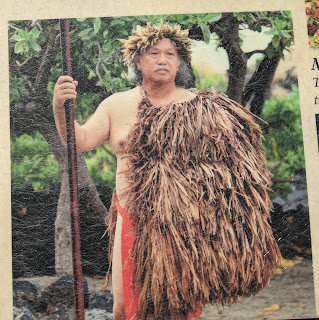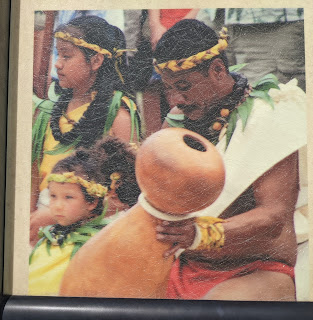Street art on the island's west coast of Wailua-Kona where we were staying:
The painting showed a slice of life along the Kona coast in the late 1700s.
As this was the last day of our incredible three-week extravaganza in the Hawaiian islands, Steven and I decided to start the day at Honokohau Beach. A five-minute walk on a well-beaten path from the parking lot took us to the beautiful hook-shaped beach which was a mix of black lava and white coral. A sign warned us about dangerous surf conditions but all was quiet that day.
Close to shore were anchialine pools, which were pools of brackish water described as perfect habitats for both marine and plant life.
I wasn't sure but I think this was a high school science class out enjoying a field trip at the park. They were all agog after coming across a honu or Hawaiian green sea turtle!
We were also easily able to spot several honu ourselves munching on seaweed around the ancient ‘ai’opio or fish trap. Let me tell you, we were almost as excited as the high schoolers seeing them close enough but still at a respectful distance. Thank goodness, there were no yahoos trying to touch these turtles as there had been at other beaches!
I’d read that every species of sea turtle in US territorial waters is protected under the Endangered Species Act because it has been designated as threatened or endangered. Luckily, the Hawaiian green sea turtle is a little more fortunate than most other green sea turtle populations because it nests away from land-based predators and egg collectors on uninhabited islands. However, some have perished by drowning in artificial fishing nets and floating debris or via a virus that causes tumors.
What a simple joy it was to watch the turtle try so, so hard to get up onto the rocks. When he never seemed to give up, it reminded me of the children's story of the tortoise and the hare!
Steven and I took turns later walking out to the other end of the beach which was bordered by the remains of an ancient heiau or temple.
A sign proclaimed it was the Maliu Point Resource Area which was sacred to the Hawaiian people, and therefore a place deserving of everyone's respect and protection. As a result, no picnicking, sunbathing, or playing of games was allowed there.
Views from the point took in the jaw-dropping waters of the Pacific:
A view back toward the beach:
On my way back to the beach, I was lucky enough to spot another turtle and watched it for ages.
Taking our stuff with us, Steven and I then strolled down the beach a ways in the other direction.
It was definitely our lucky day as we were rewarded with the sight of yet another turtle.
We dragged ourselves away from the idyllic beach as just north of Honokohau Harbor on the ocean side of the highway was the 1,160-acre Kaloko-Honokohau National Historical Park, possibly the Kona Coast’s most under-appreciated ancient Hawaiian site.
The historical park was established in 1978 partially to protect this area of land from what was anticipated would be unimpeded urbanization. Thanks to that foresight, the park is a protected place that reflected traditional Hawaiian culture. Even though it was a small park, its proximity to substantial urban development has posed many of the same issues that challenge law enforcement officials across the island. Not only are the park rangers responsible for preserving and protecting the plentiful natural and cultural resources within the park, but they also have to deal with increased crime, illegal camping, theft, and drug-related incidents. The memorial honored a 15-year park ranger who was protecting critically endangered areas of the park when he was shot and killed.
Ancient Hawaiians chose to settle on what looked like inhospitable lava fields because there were cool, brackish water springs which meant there was enough of an underwater water source for their everyday water needs.
Another factor was the spirit of Kaloko-Honokohau they felt here in every rock and tree, in the bay's calm waters, and in the trade winds that swept across the land. I learned they felt the mana or power of the spirit. Their simple philosophy was providing for the land meant the land would then provide for them, Living in such perfect harmony with the land and their remarkable faith in their gods, they became one with the land and not only survived but flourished in a highly esteemed culture.
Through the preservation of the park's cultural and natural resources, many of its historical, cultural, and archaeological features have remained intact. This has inspired the reawakening of Hawaiian culture and spiritual connections to a way of life followed on this and other islands in Hawaii.
The spirit of the land: Ancient Hawaiians carefully nurtured the natural resources as they believed to misuse them would bring the wrath of the all-powerful gods upon them and devastation to their land. Everything the land and sea had to offer was used: stone, wood, bark, fiber, sap, marine plants, fruits, nuts, fowl, and other animals. Tools made from wood, rock, fiber, and shell meant they could cultivate the land, build hale or homes, and log upland forests for canoes.
The spirit of the sea: The ancients modified shallow bays by enclosing them with rocks, thereby creating fish traps. After the fish swam into the trap at high tide through a narrow channel, they were netted when they tried to leave the channel at low tide.
Completely enclosed fish ponds were also developed by building wooden sluice gates that controlled what entered and left the pond and also made fish collection easy. A dependable food source was guaranteed by growing the fish to maturity. A great achievement of the Hawaiian people was the evolution from the fish trap to the fish pond.
The coastal people became one with the sea by protecting the resources with kapu or laws. Certain fish, for example, were kapu for taking in the spawning season when they lay eggs.
Wanting to pass sites that represented why the park was created, we followed the Mountain-Ocean Trail that cut across the park. We were curious about this place where Hawaiian values and traditions were promoted including the importance of family and caring for one another were taught.
After a while, the lava field gave way to different terrain with lots of brush and some scattered trees.
Naio or false sandalwood were indigenous plants.
Noni fruit trees:
'Ilima were also indigenous plants.
As we knew from seeing petroglyphs at other sites in Hawaii, ancient people recorded their history, traditions, and beliefs as images pecked into the rock before written language. Scientists are the first to admit that interpreting petroglyphs is precarious. However, kupuna or elders, researchers, and oral histories have attempted to interpret some of them.
At the park’s northern end was Kaloko Fishpond. Its enormous rock retaining wall was completely rebuilt in the way of the ancients which meant dry stacking and no mortar or shaping of the stones so that it could again be fished in the traditional way.
Locals believe that strength and spirit literally flow through this loko kuapa or walled fishpond and the stone wall. The kuapa is said to absorb wave energy and allow water through. With changing tides, fish swim in and out of the pond through the ‘auwai kai or channel. Larger fish are prevented to get in via a sluice gate or makaha.
We spotted a few Hawaiian Stilts foraging in the shallow water near the fish pond. In case you think we know our birds all of a sudden, let me tell you there was a sign indicating the type of bird!
Some believe that the bones of Kamehameha the Great were secretly buried in a cave nearby.
Later that day we finally made time to walk around the town of Kailua-Kona by starting off at the Royal Kona Resort which displayed paintings of past Hawaiian rulers.
At the resort's entrance was the Tiki or Ki'i as pronounced in Hawaii, representations of the gods imbued with their essence and reminders of their power. The ki'i had three different heads and therefore three different god names and attributes.
If you got up and close to the hotel, its style reminded us of an old ship that had been battered too strongly by the sea!
How sad is it that restaurant owners feel compelled to post such signs because of too many unruly customers? Is this only an American disgrace or are other countries facing similar tirades?
Our view from the last dinner we had in Hawaii was far more pleasant than the food but at least the company was great!
It was neat to see a game of beach volleyball being played just off the main street.
Much as Steven and I loved Hawaii and by this I mean the Big Island and the state of Hawaii itself, the number of panhandlers in downtown Kailua-Kona was extremely off-putting to us. It didn't make us want to linger and window shop at all.
Even though this wouldn't have been the way we wanted to say goodbye to one of this country's most beautiful and remarkable states, after three exciting weeks we left with some extraordinarily positive memories that will absolutely overshadow this minor blip.
Next post: From Hawaii to the City by the Bay, San Francisco, to spend more time with our son and his family.
Posted on June 9th, 2022, from Steady Brook in western Newfoundland, Canada's easternmost province. Since we got married 40 years ago this past February, Steven and I had visited all the other provinces together but this was his first trip to the province that only became part of Canada in 1949. With 2.5 weeks here, I think he's well on his way to making up for lost time but I'm getting way ahead of myself!















































































From the idyllic tropical islands of Hawaii and now to Canada's eastern island of Newfoundland, you two sure get around ! Annie, your photos of Hawaii are truly wonderful and capture the magic of the island and the fabulous marine life that call it their home. Thanks SO MUCH for the tour. xoxo xo
ReplyDeleteThanks, Lina, for the kind words. We are absolutely AGOG with the beauty at every turn here in Newfoundland. The weather gods even blessed us with 68-degree sunny weather all day today so idyllic for hiking in Gros Morne National Park and at Trout River. Have you been to the west coast of NL?
ReplyDeleteXOXO